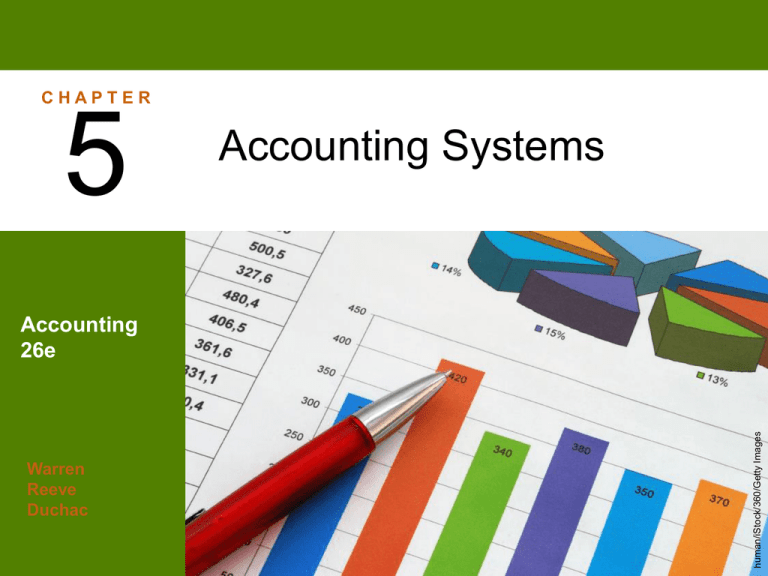
CHAPTER
5
Accounting Systems
Warren
Reeve
Duchac
human/iStock/360/Getty Images
Accounting
26e
Basic Accounting Systems
(slide 1 of 2)
•
•
An accounting system is the methods and procedures
for collecting, classifying, summarizing, and reporting
a business’s financial and operating information.
As a business grows and changes, its accounting
system also changes in the following three-step
process.
o
o
o
Step 1: Analyze user information needs.
Step 2: Design the system to meet the user needs.
Step 3: Implement the system.
©2016 Cengage Learning. All Rights Reserved. May not be scanned, copied or duplicated, or posted to a publicly accessible website, in whole or in part.
Basic Accounting Systems
(slide 2 of 2)
•
•
Internal controls are the policies and procedures that
protect assets from misuse, ensure that business
information is accurate, and ensure that laws and
regulations are being followed.
Processing methods are the means by which the
accounting system collects, summarizes, and reports
accounting information. These methods may be either
manual or computerized.
©2016 Cengage Learning. All Rights Reserved. May not be scanned, copied or duplicated, or posted to a publicly accessible website, in whole or in part.
Manual Accounting Systems
•
•
Understanding a manual accounting system is useful in
identifying relationships between accounting data and
reports.
When a business has a large number of similar
transactions, using an all-purpose (two-column) journal
is inefficient and impractical. In such cases, subsidiary
ledgers and special journals are useful.
©2016 Cengage Learning. All Rights Reserved. May not be scanned, copied or duplicated, or posted to a publicly accessible website, in whole or in part.
Subsidiary Ledgers
(slide 1 of 2)
•
•
•
A large number of individual accounts with a common
characteristic can be grouped together in a separate
ledger called a subsidiary ledger.
The primary ledger, which contains all of the balance
sheet and income statement accounts, is called the
general ledger.
Each subsidiary ledger is represented in the general
ledger by a summarizing account, called a controlling
account.
©2016 Cengage Learning. All Rights Reserved. May not be scanned, copied or duplicated, or posted to a publicly accessible website, in whole or in part.
Subsidiary Ledgers
(slide 2 of 2)
•
Two of the most common subsidiary ledgers are the
accounts receivable subsidiary ledger and the
accounts payable subsidiary ledger.
o
o
The accounts receivable subsidiary ledger, or customers
ledger, lists the individual customer accounts in alphabetical
order. The controlling account in the general ledger that
summarizes the debits and credits to the individual customer
accounts is Accounts Receivable.
The accounts payable subsidiary ledger, or creditors
ledger, lists individual creditor accounts in alphabetical
order. The related controlling account in the general ledger
is Accounts Payable.
©2016 Cengage Learning. All Rights Reserved. May not be scanned, copied or duplicated, or posted to a publicly accessible website, in whole or in part.
Special Journals
(slide 1 of 2)
•
•
•
One method of processing transactions more
efficiently in a manual system is to use special
journals.
Special journals are designed to be used for
recording a single kind of transaction that occurs
frequently.
The all-purpose two-column journal, called the general
journal or simply the journal, can be used for entries
that do not fit into any of the special journals.
©2016 Cengage Learning. All Rights Reserved. May not be scanned, copied or duplicated, or posted to a publicly accessible website, in whole or in part.
Special Journals
(slide 2 of 2)
©2016 Cengage Learning. All Rights Reserved. May not be scanned, copied or duplicated, or posted to a publicly accessible website, in whole or in part.
Revenue Journal
•
•
•
The revenue journal is used for recording fees earned
on account.
Revenues are normally recorded in the revenue journal
when the company sends a bill, or invoice, to the
customer.
Each invoice is normally numbered in sequence for
future reference.
©2016 Cengage Learning. All Rights Reserved. May not be scanned, copied or duplicated, or posted to a publicly accessible website, in whole or in part.
Cash Receipts Journal
•
•
•
•
All transactions that involve the receipt of cash are
recorded in a cash receipts journal.
Every entry recorded in the cash receipts journal will
involve a debit to the Cash Dr. column.
The types of cash receipt transactions and their
frequency determine the titles of the other columns.
For example, if a business frequently receives cash
from customers on account, an Accounts Receivable Cr.
column is set up.
The receipt of cash for infrequent transactions will be
listed individually in the Other Accounts Cr. column.
©2016 Cengage Learning. All Rights Reserved. May not be scanned, copied or duplicated, or posted to a publicly accessible website, in whole or in part.
Accounts Receivable Control Account
and Subsidiary Ledger
•
After all posting has been completed for the month,
the total of the accounts in the accounts receivable
subsidiary ledger should equal the balance of the
accounts receivable controlling account in the general
ledger.
©2016 Cengage Learning. All Rights Reserved. May not be scanned, copied or duplicated, or posted to a publicly accessible website, in whole or in part.
Purchases Journal
•
•
•
•
The purchases journal is designed for recording all
purchases on account.
Every entry recorded in the purchases journal will
involve a credit to the Accounts Payable Cr. column.
The items most often purchased on account will
determine the titles of the other columns. For example,
if the purchase of supplies on account occurs
frequently, then a Supplies Dr. column is set up.
The items purchased on account infrequently will be
listed individually in the Other Accounts Dr. column.
©2016 Cengage Learning. All Rights Reserved. May not be scanned, copied or duplicated, or posted to a publicly accessible website, in whole or in part.
Cash Payments Journal
•
•
•
•
All transactions that involve the payment of cash are
recorded in the cash payments journal.
Every entry recorded in the cash payments journal will
involve a credit to the Cash Cr. column.
The kinds of transactions in which cash is paid and
how often they occur determine the titles of the other
columns. For example, if the payment of cash to
creditors on account occurs frequently, then a Accounts
Payable Dr. column is set up.
The payment of cash for infrequent transactions will
be listed individually in the Other Accounts Dr. column.
©2016 Cengage Learning. All Rights Reserved. May not be scanned, copied or duplicated, or posted to a publicly accessible website, in whole or in part.
Accounts Payable Control Account
and Subsidiary Ledger
•
After all posting has been completed for the month,
the total of the accounts in the accounts payable
subsidiary ledger should equal the balance of the
accounts payable controlling account in the general
ledger.
©2016 Cengage Learning. All Rights Reserved. May not be scanned, copied or duplicated, or posted to a publicly accessible website, in whole or in part.
Computerized Accounting Systems
•
Computerized accounting systems have the following
three main advantages over manual systems:
o
o
o
Computerized systems simplify the record-keeping process
by recording transactions in electronic journals or forms and,
at the same time, posting them electronically to general and
subsidiary ledger accounts.
Computerized systems are generally more accurate than
manual systems.
Computerized systems provide management with current
account balance information to support decision making,
since account balances are posted as the transactions occur.
©2016 Cengage Learning. All Rights Reserved. May not be scanned, copied or duplicated, or posted to a publicly accessible website, in whole or in part.
E-Commerce
•
•
•
•
Using the Internet to perform business transactions is termed
e-commerce.
When transactions are between a company and a consumer, it
is termed B2C (business-to-consumer)
e-commerce.
When transactions are between two companies, it is termed
B2B (business-to-business) e-commerce.
Three additional areas where the Internet is being used for
business purposes are:
o
o
o
Supply chain management (SCM)
Customer relationship management (CRM)
Product life-cycle management (PLM)
©2016 Cengage Learning. All Rights Reserved. May not be scanned, copied or duplicated, or posted to a publicly accessible website, in whole or in part.
Financial Analysis and Interpretation:
Segment Analysis
•
•
•
One way to report revenue is by different segments.
Businesses may be segmented by region, by product
or service, or by type of customer.
The segment information can be used to perform
horizontal analysis using the prior year as the base
year.
In addition, vertical analysis can be performed on the
segment disclosures.
©2016 Cengage Learning. All Rights Reserved. May not be scanned, copied or duplicated, or posted to a publicly accessible website, in whole or in part.







